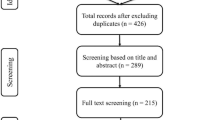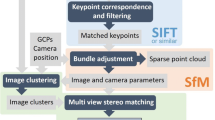Abstract
Estimation of individual tree seedling biomass isrequired in a variety of forest management andresearch applications such as assessment of netprimary productivity and carbon sequestrationpotential of forest stands, understory forest fuelinventories, and development of silviculturalguidelines to promote the growth of desired treespecies. Photo imagery is a promising non-destructivemethod for estimating the aboveground biomass of treeseedlings. This method was tested using naturallyregenerated white spruce (Picea glauca (Moench)Voss) seedlings growing in the understory of a mixedconifer shelterwood in central Ontario. In the fall of1997, 45 seedlings were sampled from plots exposed toone of three mechanical release treatments (earlyspring release, mid summer release, and no release(control)) in 1994. Each seedling was photographed inthe field to measure the vertical projected area(silhouette area) of the aboveground portion of theseedling. Seedlings were harvested, basal diameter andtotal height measured, and biomass (dry mass) offoliage, branches, main stem and total abovegroundplant tissue determined. Regression analysis revealeda strong relationship between both silhouette area andbasal diameter, and seedling biomass. Coefficients ofdetermination for regression equations usingsilhouette area were equal to 0.892, 0.918, 0.926, and0.937 for the main stem, branches, foliage, and totalaboveground biomass, respectively. Respectivecoefficients of determination for regression equationsusing basal diameter were 0.960, 0.945, 0.953, and0.977. Silhouette area-based equations for totalaboveground and foliar biomass differed significantly(P < 0.005) among release treatments. Nosignificant differences among treatments were observedbetween silhouette area-based equations for biomass ofbranches and main stem (P > 0.05), or betweenbasal diameter-biomass (allometric) equations for allcomponents (P > 0.1). The method was thentested by validating the biomass equations using anindependent data set from 35 white spruce seedlingsfrom the same site and cohort, but exposed todifferent treatments and microenvironmentalconditions. For each seedling, biomass components werepredicted using silhouette area-based and allometricequations, and a relative error of predictioncalculated. The mean relative error for silhouettearea-based predictions varied among biomass componentsfrom −20.25% to −3.21%, with standard deviation ofthe error ranging from 23.04% to 33.44%. The meanrelative error for allometric equations ranged from−2.46% to −21.75%, with standard deviations of23.34% to 32.61%. These results suggest that: (1)photo imagery can be used as an alternative to moretraditional allometric methods of biomass estimation,and (2) general (developed for a broad range ofgrowing conditions) equations derived by either methodare preferable to those specifically calibrated for agiven growing environment.
Similar content being viewed by others
References
Agee, J. K. 1983. Fuel weights of understory-grown conifers in southern Oregon. Canadian Journal of Forest Research 13: 648-656.
Baskerville, G. L. 1972. Use of logarithmic regression in the estimation of plant biomass. Canadian Journal of Forest Research 2: 49-53.
Brand, G. J. and Smith, W. B. 1985. Evaluating allometric shrub biomass equations fit to generated data. Canadian Journal of Botany 63: 64-67.
Edwards, M. B. and McNab, W. H. 1979. Biomass prediction for young southern pines. Journal of Forestry 77: 291-292.
Feller, M. C. 1992. Generalized versus site-specific biomass regression equations for Pseudotsuga menziesii var. menziesii and Thuja plicata in Coastal British Columbia. Bioresource Technology 39: 9-16.
Hann, D.W., Walters, D. K. and Scrivani, J. A. 1987. Incorporating crown ratio into prediction equations for Douglas-fir stem volume. Canadian Journal of Forest Research 17: 17-22.
Hitchcock, H. C., III. 1978. Aboveground tree weight equations for hardwood seedlings and saplings. TAPPI 61: 119-120.
Koerper, G. J. and Richardson, C. J. 1980. Biomass and net annual primary production regressions for Populus grandidentata on three sites in northern lower Michigan. Canadian Journal of Forest Research 10: 92-101.
Media Cybernetics. 1994. Image-Pro Plus for Windows, ver. 1.2.01. Silver Spring, Maryland, US.
Morris, D. M., MacDonald, G. B. and McClain, K. M. 1990. Evaluation of morphological attributes as response variables to perennial competition for 4-year-old black spruce and jack pine seedlings. Canadian Journal of Forest Research 20: 1696-1703.
Norgren, O., Elfving, B. and Olsson, O. 1995. Non-destructive biomass estimation of tree seedlings using image analysis. Scandinavian Journal of Forest Research 10: 347-352.
Parker, W. C. 1998. The growth response of white spruce seedlings to seasonal timing of mechanical release from understory competition in an Ontario shelterwood, pp. 242-245. In: Wagner, R. G. and Thompson D. G., compilers, Third International Conference on Vegetation Management: Popular Summaries. Ontario Ministry of Natural Resources, Ontario Forest Research Institute, Forest Research Information Paper No. 141, 508 pp.
Pastor, J., Aber, J. D. and Melillo, J.M. 1984. Biomass prediction using generalized allometric regressions for some northeast tree species. Forest Ecology and Management 7: 265-274.
Plonski, W. L. 1974. Normal yield tables (metric) for major forest species of Ontario, Ontario Ministry of Natural Resources, Queens Printer for Ontario, Ottawa, ON, 49 pp.
Ratkowsky, D. A. 1983. Nonlinear Regression Modeling: A Unified Practical Approach. Marcel Dekker, Inc., New York, New York. 276 pp.
Reed, D. D., Mroz, G. D., Liechty, H. O., Jones, E.A., Cattelino, P. J., Balster, N. and Zhang,Y. 1995. Above-and below-ground biomass of precompetitive red pine in northern Michigan. Canadian Journal of Forest Research 25: 1064-1069.
Seber, G. A. F. 1977. Linear Regression Analysis. John Wiley and Sons, Inc., New York. 465 pp.
Smith, W. B. and Brand, G. J. 1983. Allometric biomass equations for 98 species of herbs, shrubs, and small trees. USDA Forest Service, North Central Forest Experiment Station, Research Note NC-299. 8 pp.
Suh, S.-R. and Miles, G. E. 1988. Measurement of morphological properties of tree seedlings using machine vision and image processing. American Society of Agricultural Engineers, Paper No.88-1542, St. Joseph, Michigan, USA. 16 pp.
Telfer, E. S. 1969. Weight-diameter relationships for 22 woody plant species. Canadian Journal of Botany 47: 1851-1855.
Ter-Mikaelian, M. T., Parker, W. C. and Paterson, J. M. 1997. Photo imagery: A nondestructive method for estimating tree biomass. Ontario Ministry of Natural Resources, Ontario Forest Research Institute, Forest Research Report 144, Sault Ste. Marie, Ontario, Canada. 10 pp.
Wagner, R. G. and Ter-Mikaelian, M. T. 1999. Comparison of biomass component equations for four species of northern coniferous tree seedlings. Annals of Forest Science 56: 193-199.
Williams, R. A. and McClenahen, J. R. 1984. Biomass prediction equations for seedlings, sprouts, and saplings of ten central hardwood species. Forest Science 30: 523-527.
Young, H. E., Ribe, J. H. and Wainwright, K. 1980. Weight tables for tree and shrub species in Maine. Life Sciences and Agriculture Experiment Station, University of Maine at Orono, Miscellaneous Report 230. 84 pp.
Zutter, B. R., Gjerstad, D. H. and Glover, G. R. 1986. Effects of interfering vegetation on biomass, fascicle morphology, and leaf area of loblolly pine seedlings. Forest Science 32: 1016-1031.
Author information
Authors and Affiliations
Corresponding author
Rights and permissions
About this article
Cite this article
Ter-Mikaelian, M.T., Parker, W.C. Estimating biomass of white spruce seedlings with vertical photo imagery. New Forests 20, 145–162 (2000). https://doi.org/10.1023/A:1006716406751
Issue Date:
DOI: https://doi.org/10.1023/A:1006716406751




